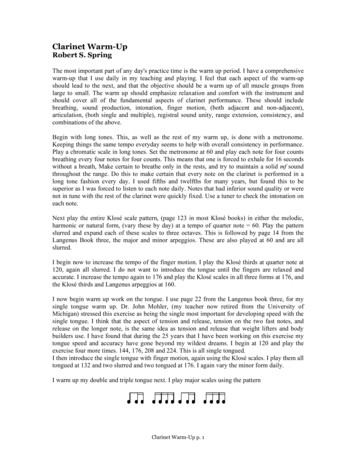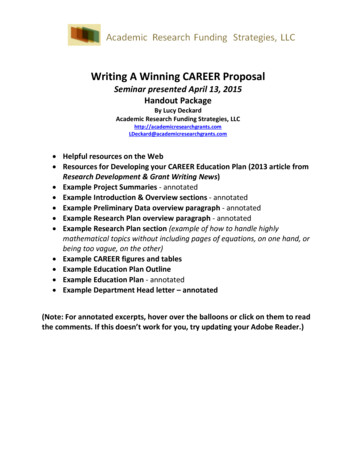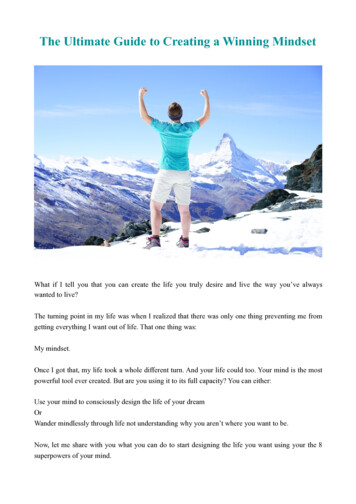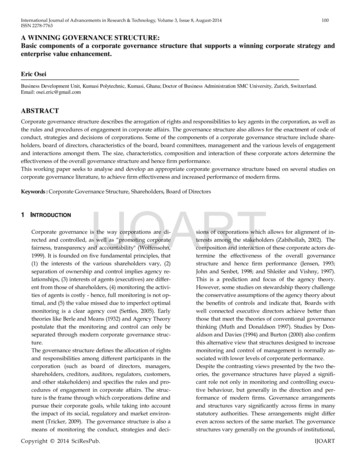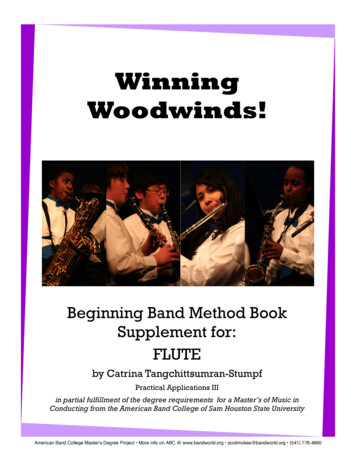
Transcription
WinningWoodwinds!Beginning Band Method BookSupplement for:FLUTEby Catrina Tangchittsumran-StumpfPractical Applications IIIin partial fulfillment of the degree requirements for a Master’s of Music inConducting from the American Band College of Sam Houston State UniversityAmerican Band College Master's Degree Project More info on ABC @ www.bandworld.org scottmckee@bandworld.org (541) 778-4880
American Band College Master's Degree Project More info on ABC @ www.bandworld.org scottmckee@bandworld.org (541) 778-4880
WINNING WOODWINDSTable of ContentsIntroduction. 2Developing Proper Seated Posture . 3Developing Correct Breathing Habits . 4-5Parts of the Instrument . 6Forming the Embouchure . 7-9Weight Training for Your Lips: Chopsticks! . 10What if it Doesn’t Sound Right? Common Problems & Solutions .11-12Parts of the Instrument & Instrument Assembly.13-14Instrument Care & Maintenance.15-16Hand Position .17-18Developing Muscle Memory: Finger Wiggling. 19Posture while Holding the Flute . 20Reading Treble Clef .21-22Reading Rhythms.23-24Time Signature .25-26Putting it All Together (Reading & Playing Music) .27-31Flute Fingering Chart .32-34Treble Clef Flash Cards.35-42Acknowledgements/About the Author . 44Works Cited.45-46American Band College Master's Degree Project More info on ABC @ www.bandworld.org scottmckee@bandworld.org (541) 778-4880
American Band College Master's Degree Project More info on ABC @ www.bandworld.org scottmckee@bandworld.org (541) 778-4880
WINNING WOODWINDS: FLUTEPAGE 2Congratulations, you’ve decided to play a woodwind instrument! This bookwill help guide you through the process of developing correct habits forposture, breathing, tone quality, and hand position. It will also give youinformation on how to take care of your instrument in order to keep it in good,working condition at all times. This book is designed to be a supplement towhatever method book your school band teacher or your private musicinstructor already uses.Remember that playing a musical instrument is a physical activity whichrequires you to use your facial (and other) muscles in a new and different way.When you first start playing, you may only be able to practice for a few minutesat a time before you get tired. That’s okay! Practicing on a daily basis will helpyou build your endurance and allow you to play with a better sound for a longerperiod of time. So even if you have trouble at the start, don’t give up!Regardless of which woodwind instrument you choose to play, here is a list ofitems you will need in order to develop good playing habits: Your instrument & method bookA music standA small mirror (set on your music stand so you can see yourself in it.)A pencil (to mark down reminders!)A cleaning rod and handkerchief or a swabA polishing cloth for your instrumentAppropriate reeds (for clarinet & bassoon)Recommended items: A metronome (a small device that you set to click and/or blink at aregular rate to make sure you don’t speed up or slow down when youplay. ) If you don't own a metronome, a free one is available online atwww.metronomeonline.comA chromatic tuner (a small device that will tell you what note you areplaying, and if the pitch is accurate.) If you don’t own a metronomebut you have a computer with a microphone, a free chromatic tuner isavailable online at www.seventhstring.com/tuner/tuner.htmlAmerican Band College Master's Degree Project More info on ABC @ www.bandworld.org scottmckee@bandworld.org (541) 778-4880
PAGE 3WINNING WOODWINDS: FLUTEDeveloping Proper Seated PostureBefore we start learning how to play our instrument, we need to first start to develop proper posture. Correct posture isn’t just about looking professionalwhile you play—it helps you breathe better. This is important, since you havechosen to play a wind instrument!Imagine a garden hose that’s turned on full blast. If you bend the hose, the flowof water will slow down or stop altogether. When you hunch over, you are putting a “kink” in your airway, which makes it more difficult to breathe in and out.Seated Posture1. Sit on the front edge of your chair with your feet flat on the floor and spreadshoulder width apart. Your weight should be distributed far enough forwardthat you can stand straight up without having to shift your weight first.2. Push your spine slightly forward towards your navel until you are sitting upright and tall.3. Make sure your shoulders, arms and neck stay relaxed. You should be comfortable enough to sit in this position for quite a while.Yes!Yes!No!Yes!American Band College Master's Degree Project More info on ABC @ www.bandworld.org scottmckee@bandworld.org (541) 778-4880
PAGE 4WINNING WOODWINDS: FLUTEDeveloping Correct Breathing HabitsYou may look at this section and think, “What do I need to learn aboutbreathing? I’ve managed to live on this earth for years and have successfullyinhaled and exhaled enough to still be here today!”Playing a musical instrument requires you to use more air than you wouldnormally use when you’re just sitting around having a conversation with friends.It also means that you have to learn how to control the rate and speed of the airthat you use.Developing good posture will help allow you to breathe in large amounts of airquickly.Breathing Technique1. Start by laying on the floor, flat on your back, with one hand on your stomachand the other hand on your upper chest. Relax and breathe naturally for afew minutes. You should notice that, when your body is relaxed, yourabdomen expands first, and then your chest does when you inhale. As youexhale, your chest deflates first, then your abdomen.2. Sit in your chair (while demonstrating proper posture.) Relax your shouldersand try to inhale and exhale in the same way that you did while you werelying on the floor—filling your lungs all the way to the bottom first, then up toyour chest before exhaling. Try and expand your ribs outwards until you feellike they can’t expand any more before exhaling. If you are breathingproperly and expanding your lungs, your shoulders should not move verymuch as you inhale and exhale.American Band College Master's Degree Project More info on ABC @ www.bandworld.org scottmckee@bandworld.org (541) 778-4880
PAGE 5WINNING WOODWINDS: FLUTECheckpoint: Think about saying the word “OH” when you inhale and “HO” whenyou exhale. If you are breathing correctly, you should feel cold air in your throatwhen you inhale and you should be able to blow warm air onto the palm of yourhand when you exhale.3. When you play a musical instrument, you need to be able to inhale so thatyour lungs are full in a short amount of time. Try the following exercise tohelp you breathe in more quickly: Turn your metronome on to 60 beats per minute (mm 60)Inhale for 4 beats, then exhale for four beats; make sure that the air iseither constantly moving in or out; you should never stop and “hold”your breath in this exercise.Inhale the same amount of air over the course of 3 beats and exhaleover the course of 5 beats. You may need to add pressure from yourstomach muscles to keep the air moving as you exhale. (Imagineblowing out a birthday cake with 1,000 candles on it—you’ll use thosesame muscles!)Inhale for 2 beats and exhale for 6; then inhale for 1 beat and exhalefor 8.Important! If you start feeling lightheaded during these exercises,STOP, lean over to rest your headbetween your knees, and breathenaturally for a few minutes until youfeel well again! This is perfectly normal when you start a wind instrument!American Band College Master's Degree Project More info on ABC @ www.bandworld.org scottmckee@bandworld.org (541) 778-4880
PAGE 6WINNING WOODWINDS: FLUTEParts of the InstrumentBefore you get started, ask your music teacher to help you put a mark on yourcase to help you identify which side is the TOP and which side is the BOTTOM.(As a general rules, the latches flip UP to open on most cases.)Put your instrument case on the floor and open the latches. Always leave yourcase on the floor—if you attempt to assemble your instrument with your case onyour lap, you could drop it!When you open your case, this is what you should see:TenonKeysBODYRodBarrelRodFOOT JOINT E-flat key CrownA-flat key(points towards thecenter of the case.)HEAD JOINTLip PlateEmbouchure HoleTenonFor right now, all you will need to get started is the head joint. Take it out of thecase, then close and latch your case and leave it on the floor.American Band College Master's Degree Project More info on ABC @ www.bandworld.org scottmckee@bandworld.org (541) 778-4880
PAGE 7WINNING WOODWINDS: FLUTEForming the Embouchure“Embouchure” (pronounced AHM-buh-shur) is the term for the way you formyour lips and facial muscles in order to play a wind instrument. The term comesfrom the French word bouche (pronounced boosh) which means “mouth.”Materials you may want to have nearby to help in this section: Your flute head jointA small handful of uncooked rice (20 grains)A mirrorStep 1: Spitting Rice (Note: It’s probably best to do this activity outside.) Sit or stand up straight. If you are standing, your weight should bedistributed evenly over both legs, you should be standing tall (pushingyour spine slightly towards your belly button), your shoulders andhead should be relaxed and balanced. Put a single grain of rice in between the center of your lips. Look straight ahead and use your tongue to try and launch (spit) thepiece of rice off of your top of your lip at a 45 degree angle away fromyour body. Your tongue should touch the spot where your upper teethand your upper lip meet. Practice this several times until you can do it consistently.Step 2: “See Sue Too” Sit or stand with good posture. Look in the mirror and say theword “See”—the corners ofyour lips should pull backslightly. If you’d like, make a “V” withyour index and middle fingersand place them at the corner ofyour mouth as a reminder toAmerican Band College Master's Degree Project More info on ABC @ www.bandworld.org scottmckee@bandworld.org (541) 778-4880
WINNING WOODWINDS: FLUTE PAGE 8keep your corners in place. There should still be space between yourmolars (your back teeth.)While saying “see,” add the word “sue,” and then the word“too” (exhaling at a 45 degree angle, justlike you did when you were spitting rice.)Watch yourself in the mirror and practicesaying “See Sue Too” several times over.Step 3: Holding the head joint. Sit or stand with good posture. (Have younotice yet that you should always start withgood posture?) Hold the head joint with two hands (your left hand at the crown, yourright hand at the tenon with your palm facing away from your body)and place the lip plate firmly into the “nook” of your chin. This is your“snuggle spot” where the head joint rests—hole the head joint firmlyenough in your chin that it would be hard for someone to try to take itaway from you. Look in the mirror. Your lower lip should slightly cover the tone hole(like in the photo), and you should still be able to speak comfortably.Step 4: Producing a tone (FINALLY!) Look at the embouchure hole on your head joint and find the inside ofthe wall of the tone hole—this is where you are going to aim your airstream. Pick up the head joint and place thelip plate against your chin. Take in a deep breath (like you areyawning or saying “OH”)—youLip PlateAimairhereshould feel cold air in the back of“Snuggleyour throat when you inhale. MakeSpot”sure your body is relaxed and yourshoulders stay low when you do this!American Band College Master's Degree Project More info on ABC @ www.bandworld.org scottmckee@bandworld.org (541) 778-4880
PAGE 9WINNING WOODWINDS: FLUTENo squished shoulders!Relaxed, “OH” inhale As you inhale, set your embouchure by thinking “See” then adding“Sue.”Say “Too” and exhale with a continuous air stream.Use your abdominal muscles to keep your air stream going!Embouchure with Head Joint (Side View)“SEE”“SUE”“TOO”American Band College Master's Degree Project More info on ABC @ www.bandworld.org scottmckee@bandworld.org (541) 778-4880
PAGE 10WINNING WOODWINDS: FLUTEWeight Training for Your Lips!Now that you understand the basic principles of forming your embouchure, hereare a couple of exercises to help you keep it strong.Materials you may want to have nearby to help in this section: Your flute head jointA mirrorTwo chopsticks (the round wooden kind) or bamboo skewersA tunerExercise 1: Making an “A” Put your tuner on the music stand in front of you. Bring your head joint firmly to the chin, say “See-Sue-(breathe)-Too”to set t
WINNING WOODWINDS: FLUTE PAGE 2 Congratulations, you’ve decided to play a woodwind instrument! This book will help guide you through the process of developing correct habits for posture, breathing, tone quality, and hand position . It will also give you information on how to take care of your instrument in order to keep it in good,

